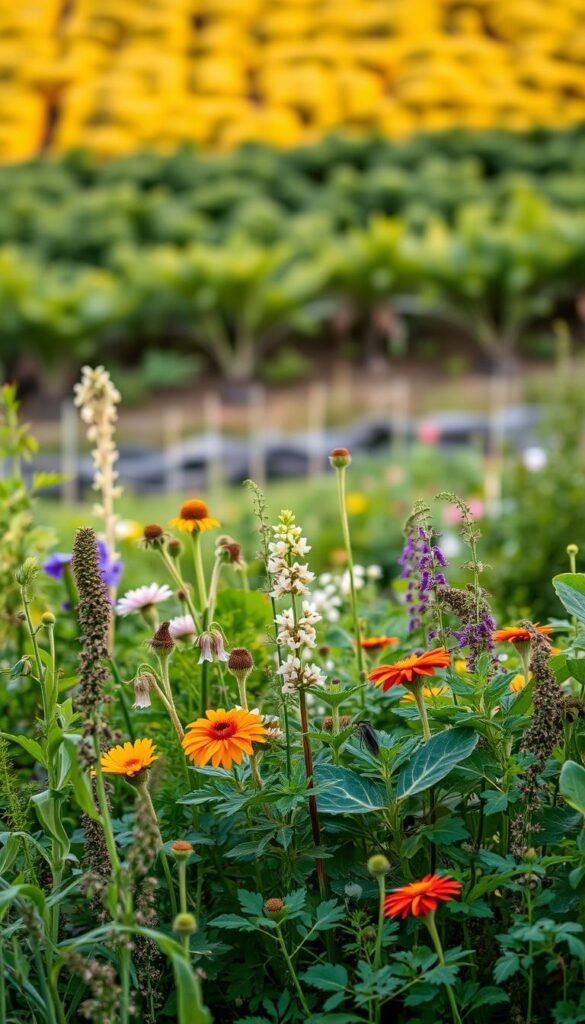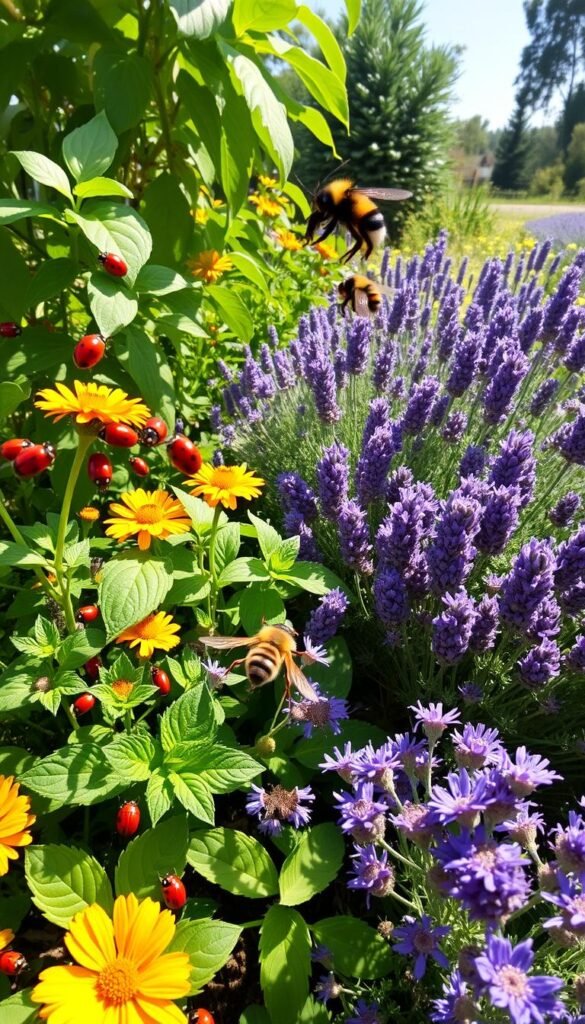Did you know thriving plants naturally repel unwanted visitors? Research reveals that insects and diseases primarily target weaker specimens—a critical part of nature’s cleanup crew. This means your green space’s success hinges not on battling pests, but on cultivating resilient growth through balanced ecosystems.
Many experienced growers overlook this fundamental truth. By focusing on soil vitality and nutrient harmony, you create an environment where beneficial microbes and insects become your allies. Discover how this approach reduces reliance on synthetic solutions while boosting your harvest’s nutritional value.
Plants communicate their needs through subtle signs. Yellowing leaves or stunted growth often point to soil imbalances affecting natural resistance. Addressing these root causes strengthens your garden’s defenses more effectively than reactive pest control measures.
This method works across growing styles—whether you’re nurturing traditional beds or exploring alternative cultivation techniques. The principles remain consistent: optimize sunlight exposure, maintain proper moisture levels, and foster biological diversity.
You’ll soon realize that vibrant, pest-resistant crops aren’t just possible—they’re nature’s default when we work with ecological patterns rather than against them. Let’s explore how simple shifts in perspective and practice can transform your growing results.
Starting with a Strong Organic Garden Foundation
The secret to a thriving garden lies beneath the surface. Your soil’s health determines whether plants flourish or struggle. Focus on creating balanced conditions where roots access nutrients while beneficial organisms thrive.
Building Healthy Soil with Compost
Quality compost should smell like fresh earth, not rot. Test yours by squeezing a handful—it should hold shape briefly before crumbling. Avoid materials treated with herbicides, as residues can linger for years.
Most spaces need just 1/3 cubic yard of compost per 1,000 sq ft annually. Overdoing it creates soggy soil and nutrient imbalances that weaken plants. A compact worm compost bin often supplies enough organic matter for small plots while fitting neatly on patios.
Using Mulch to Conserve Moisture
Leaves outperform wood chips in vegetable beds by decomposing faster and improving soil structure. Spread 2-3 inches around plants, keeping stems clear. This mimics forest floors where microbes break down organic matter steadily.
Wood chips work better around trees and shrubs. In annual beds, they can rob nitrogen as they decompose. Remember—mulch shouldn’t touch plant stems. Proper application prevents rot while suppressing weeds naturally.
Timing matters most. Apply compost before planting seasons and refresh mulch after soil warms. This approach avoids common beginner errors like smothering seedlings or disrupting root development.
Organic Gardening Tips for Pest-Free, Chemical-Free Produce

What if your garden could defend itself? Many common pests avoid robust ecosystems where helpful insects and smart planting strategies create natural barriers. This approach reduces reliance on harmful solutions while keeping your greens thriving.
Smart Strategies for Bug Management
Start by ditching chemical sprays. Research shows synthetic solutions linger in soil for years and harm beneficial bugs like ladybirds that eat aphids. Instead, try these earth-friendly tactics:
- Rotate crops yearly to confuse pests that target specific plants
- Interplant garlic or marigolds to repel unwanted visitors naturally
- Leave some leaf litter to shelter spiders and lacewings
Early detection prevents major damage. Check leaves weekly for chew marks or discoloration. Remove affected foliage immediately and introduce predator insects if needed. Most gardens only have 5% harmful bugs—the rest help pollination or hunt problem species.
Create bug hotels using stacked wood or hollow stems to attract helpful allies. These simple structures give ground beetles and solitary bees safe havens to thrive. Remember, a diverse ecosystem solves pest issues better than any spray bottle.
Inviting Nature’s Allies: Pest Predators and Companion Plants

Imagine your green space buzzing with helpers working overtime. Nature provides built-in solutions when you design habitats that welcome pest-eating allies. This approach turns your plot into a living defense system.
Encouraging Beneficial Insects
Ladybugs devour aphids, while lacewings feast on mites. To attract these helpers, plant dill or yarrow—their tiny flowers provide nectar. Ground beetles hunt slugs at night if you leave small rock piles as hiding spots.
“Aphid lions (lacewing larvae) can eat 200 pests weekly—no paycheck required.”
Selecting the Right Companion Plants
Strategic pairings create natural barriers. Basil planted near tomatoes repels hornworms, while sage protects carrots from flies. Sunflowers serve triple duty—they lure pollinators, deter ants, and shelter beneficial birds.
| Plant | Pest Deterred | Bonus Benefit |
|---|---|---|
| Oregano | Cabbage moths | Attracts hoverflies |
| Marigolds | Nematodes | Improves soil health |
| Nasturtiums | Squash bugs | Edible flowers |
Timing matters—plant protectors 2-3 weeks before vulnerable crops. For stubborn infestations, targeted organic pest control techniques can supplement nature’s workforce without disrupting the ecosystem.
Birds complete the defense team. Install a birdbath near berry bushes—robins will snack on caterpillars between sips. With these strategies, your garden becomes a self-regulating sanctuary.
Optimizing Soil Nutrient Balance for Resilient Plants

Ever wonder why some plants thrive while others struggle nearby? Your soil’s hidden chemistry holds the answer. Most growing spaces need specific mineral ratios to support strong growth—imbalances often lead to weak crops and pest issues.
Testing and Adjusting Soil pH
Start with a lab test—organic analysis reveals missing micronutrients like zinc or copper. Many gardeners find their soil has excess magnesium or phosphorus, causing compaction. Calcium carbonate (10 lbs per 1,000 sq ft) improves structure and helps plants absorb nutrients effectively.
Integrating Organic Fertilizers
Natural amendments feed both plants and microbes. Kelp meal provides boron, while fish emulsion offers trace minerals. Glacial rock dust replenishes over 80 elements—key for plant health and pest resistance.
| Micronutrient | Role | Natural Source |
|---|---|---|
| Boron | Cell growth | Kelp meal |
| Zinc | Enzyme production | Ocean water |
| Copper | Disease resistance | Molasses |
Timing matters—apply fertilizers early in the season for maximum uptake. Pair amendments with fertilizer basics to create balanced nutrition plans. Healthy soil grows nutrient-dense food while naturally deterring pests.
Growing Healthy Plants from Seed

What’s the secret behind vegetables bursting with flavor? It starts long before harvest—with the seeds you choose and how you nurture them. By mastering seed techniques, you create plants tailored to your space’s unique conditions, yielding tastier food each year.
Seed Starting Techniques
Begin indoors 6-8 weeks before your last frost. Use biodegradable pots to avoid root shock. Keep soil moist but not soggy—overwatering drowns delicate roots. A sunny windowsill works, but grow lights prevent leggy stems.
Direct sowing shines for cold-hardy crops. Peas and carrots thrive when planted outside early. Wait until soil reaches 60°F for heat-lovers like beans. This timing matches nature’s cycle, boosting germination rates.
| Method | Best Time | Top Crops |
|---|---|---|
| Indoor Start | Late Winter | Tomatoes, Peppers |
| Direct Sow | Early Spring | Spinach, Radishes |
| Succession Plant | Every 2 Weeks | Lettuce, Beans |
Saving Seeds from Champions
Mark your healthiest plants with colorful ribbons. Let fruits fully ripen before collecting seeds—tomato seeds need fermentation to remove inhibitors. Dry thoroughly on coffee filters, labeling with dates and traits.
Store seeds in airtight jars with silica packets. Cool basements maintain viability for 3-5 years. Each cycle of selection creates varieties resistant to local pests and weather swings.
New to starting your growing journey? Begin with easy savers like beans and lettuce. Their simple seed structures make success achievable while you learn advanced techniques.
Implementing a Holistic, Chemical-Free Gardening Approach

True garden vitality emerges when you align your practices with nature’s rhythms. Your space becomes a living network where sunlight, water, and temperature work in concert with soil biology. This method creates resilient ecosystems that flourish without synthetic interventions.
Mastering Light and Location
Plants thrive when placed according to their needs. Tomatoes demand 8+ hours of direct sun, while hostas wilt under intense rays. Observe your space through the day—note shaded areas perfect for leafy greens.
| Plant | Light Needs | Ideal Placement |
|---|---|---|
| Peppers | Full sun | South-facing beds |
| Spinach | Partial shade | Under taller crops |
| Lavender | 6+ hours sun | Rocky, well-drained areas |
Water management makes or breaks your efforts. Overwatering drowns roots and invites slugs, while drought stresses plants. Check soil moisture by pressing a finger 2 inches deep—it should feel like a wrung-out sponge.
Timing matters with temperature. Wait until soil reaches 55°F before sowing beans. In cooler climates, use cold frames to extend seasons. Match crops to your USDA zone for natural resilience.
“My best harvests come from watching nature’s cues, not fighting them,” shares Minnesota gardener Lila Chen. “When I stopped battling my climate and worked with it, everything clicked.”
This approach connects all elements. Healthy soil feeds plants that attract beneficial insects, which control pests naturally. You create cycles where each component supports the others—like nature intended.
Final Reflections on Your Organic Garden Adventure
Your journey through nurturing a thriving ecosystem reveals nature’s genius. Each step you’ve taken—from enriching soil to welcoming helpful insects—creates lasting resilience. This approach becomes easier with time, as balanced conditions reduce constant upkeep.
Remember how seedlings transformed into robust plants with minimal intervention? That’s the power of working with natural cycles. Your space now hosts intricate relationships where microbes feed roots, birds patrol for pests, and companion species protect each other.
Success lies in three simple things: observe changes weekly, replenish nutrients seasonally, and let diversity thrive. These practices build momentum—healthy spaces attract more helpers each year. What once required effort now sustains itself through smart design.
Keep experimenting with new techniques while trusting established patterns. Every challenge solved deepens your understanding of this living network. Your green haven stands proof that thoughtful gardening yields abundance without battles.






